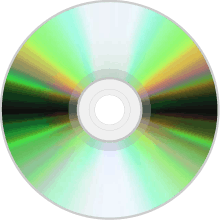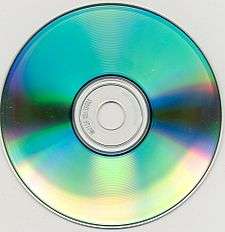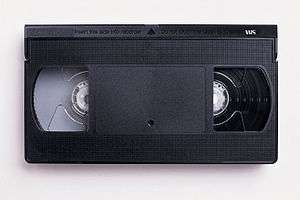Comparison of recording mediums
This article details a comparison of audio recording mediums.
Comparison
| Format | Type | Image | Typical length |
|---|---|---|---|
| Phonograph cylinders | Analog | around 2 – 4 minutes | |
| 78 rpm record | Analog |  |
around 3 – 5 minutes per side |
| 45 rpm record | Analog |  |
often around 4 minutes (EP: 7 minutes) per side, up to 6 per side, in some cases even a few minutes longer. |
| LP record | Analog |  |
typically 15–25 minutes per side (30 minutes per side for classical & spoken word), although 45 minutes is possible with tight groove spacing and no spacing between tracks. |
| Audio cassette | Analog | usually 30 (C-60) or 45 (C-90) minutes per side, 60 (C-120) minutes per side have also been sold although the tape is more prone to stretching or breaking. | |
| 8-Track | Analog | up to 100 minutes, often 45 to 80 | |
| Reel-to-Reel | Analog |  |
1.5 hours (both sides) if recorded at 7.5 inches per second (ips) on a standard 1800 ft reel.
Professionals record at 30 ips on 3600 ft reels that will fit 22.5 minutes (one side only). A 3600 ft reel can hold up to 48 hours if recorded in mono (4 sides) at 15/16 ips. |
| Compact disc | Digital |  |
Earlier discs: up to 74 minutes (or up to 650 MB of data files) |
| Later discs: up to 80 minutes (or up to 700 MB of data files) | |||
| Recordable discs | Digital |  |
Up to 99 minutes, though unlikely to be reliable after 90 minutes due to mistracking |
| Minidisc | Digital |  |
Earlier discs: 74 minutes up to 296 minutes, dependent upon compression used. |
| Later discs: 80 minutes up to 320 minutes, dependent upon compression used. | |||
| Hi-MD | Digital |  |
Up to 13 hours on a standard 80-minute MiniDisc. |
| Up to 45 hours on a 1Gb Hi-MD (MiniDisc) | |||
| Digital audio player | Digital |  |
Roughly 186 hours of playback per 10 GiB, assuming an average bitrate of 128 kbit/s. Roughly 372 hours with 64 kbit/s and roughly 74 hours with 320 kbit/s. |
| DVD | Digital |  |
around 8.5 hours per layer (4.7 Gb), with a maximum of two layers per side, which roughly equals 35 hours on a dual layered, two sided disc (can change due to compression). |
| SACD | Digital | Hybrid: A "Red Book" layer compatible with most legacy Compact Disc players, dubbed the "CD layer," and a 4.7 GB SACD layer, dubbed the "HD layer." | |
| Single-layer: Physically a DVD-5 DVD, a single-layer SACD includes a 4.7 GB HD layer with no CD layer. | |||
| Dual-layer: Physically a DVD-9 DVD, a dual-layer SACD includes two HD layers totalling 8.5 GB, with no CD layer. | |||
| HD DVD | Digital |  |
Single-layer: 15 GB |
| Dual-layer capacity: 30 GB | |||
| Blu-ray | Digital | 50 GB (23 Hours) | |
| VHS/S-VHS-tape | Analog |  |
240 minutes for PAL/SECAM, 180 minutes for NTSC |
| VHS-C/S-VHS-C-tape | Analog | 45 minutes for PAL/SECAM, 40 minutes for NTSC | |
| DAT-tape | Digital | 120 minutes | |
| DCC-tape | Digital | 105 minutes |
The typical duration of a vinyl album is about 15 to 25 minutes per side. Classical music and spoken word recordings can extend to over 30 minutes on a side. If a side exceeds the average time, the maximum groove amplitude is reduced to make room for the additional program material. This can cause hiss in the sound from lower quality amplifiers when the volume is turned up to compensate for the lower recorded level. An extreme example, Todd Rundgren's Initiation LP, with 36 minutes of music on one side, has a "technical note" at the bottom of the inner sleeve: "if the sound does not seem loud enough on your system, try re-recording the music onto tape." The total of around 40–45 minutes often influences the arrangement of tracks, with the preferred positions being the opening and closing tracks of each side.
Although the term EP is commonly used to describe a 7" single with more than two tracks, technically they are not different from a normal 7" single. The EP uses reduced dynamic range and a smaller run-off groove area to extend the playing time. However, there are examples of singles, such as The Beatles' "Hey Jude" or Queen's "Bohemian Rhapsody", which are six minutes long or more. (in 1989, RCA released 'Dreamtime' by the band Love and Rockets, which clocks at 8:40). These longer recordings would require the same technical approach as an EP. The term EP has also been used for 10" 45 rpm records, typically containing a reduced number of tracks.
Vinyl albums have a large 12" album cover, which also allows cover designers scope for imaginative designs, often including fold-outs and leaflets.
See also
- Audio format
- Audio storage
- CardTalk
- DJ
- Hard drive
- Magnetic cartridge
- RCA
- Record changer
- Record press
- Sound recording
- Unusual types of gramophone records
- Voyager Golden Record
- Vinyl Emulation Software
References
- Fadeyev, V., and C. Haber (2003). "Reconstruction of mechanically recorded sound by image processing" (PDF). Journal of the Audio Engineering Society 51 (December): 1172.
- Lawrence, Harold; "Mercury Living Presence." Compact disc liner notes. Bartók, Antal Dorati, Mercury 432 017-2. 1991.
- International standard IEC 60098: Analogue audio disk records and reproducing equipment. Third edition, International Electrotechnical Commission, 1987.
- College Physics, Sears, Zemansky, Young, 1974, LOC #73-21135, chapter: Acoustic Phenomena
Further reading
- From Tin Foil to Stereo — Evolution of the Phonograph by Oliver Read and Walter L. Welch.
- Where have all the good times gone? — the rise and fall of the record industry Louis Barfe.
- Pressing the LP record by Ellingham, Niel, published at 1 Bruach Lane, PH16 5DG, Scotland.
External links
- Creating a vinyl record
- YouTube — Record Making With Duke Ellington (1937) A look at how early 78 rpm records were made.
- Kiddie Records Weekly — Recordings and case images from children's records of the 1940s and 1950s.
| ||||||||||